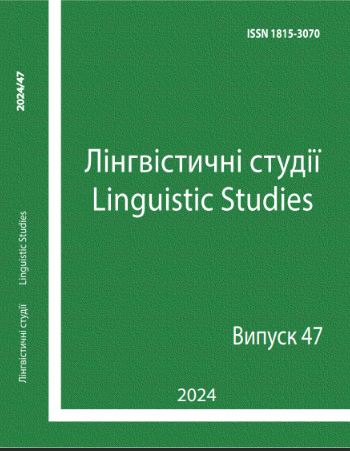Ambivalence as a criterion of cross-cultural specificity of emotional concepts: data from english and german web corpora
DOI:
https://doi.org/10.31558/1815-3070.2024.47.1Keywords:
emotion concept, cultural concept, linguoculture, ambivalence, equivalence, evaluation, language corpusAbstract
The aim of the proposed article is to verify the claim that the positive EC joy is more often interpreted negatively in British narratives than its equivalent freude in German ones, and the negative EC sadness, on the contrary, is more often interpreted positively than its German equivalent trauer. The verification is carried out by comparing the frequency and evaluation (negative vs. positive meanings) of the most relevant conceptual proximates of the semantic structure of the ECs joy – freude and sadness – trauer.
References
Bamberg, M., Ammirati, D., Shea, S. “What constitutes ‘good’ data for the study of language development? How children learn to talk about things with noname: 'double emotions'”. [V:] P.W. Davis (ed.), Alternative Linguistics. Descriptive and Theoretical Modes. Amsterdam: John Benjamins Publishing, 1995: 1–44.
Bradley, M.M., Lang, P.J. Affective norms for English words (ANEW): Instruction manual and affective ratings. Technical Report C-1, The Center for Research in Psychophysiology, University of Florida, 1999.
Doyle, C.M., Gendron, M., Lindquist, K.A. “Language is a unique context for emotion perception”. [V:] Affective Science 2/2, 2021: 171–177.
Fronhofer, N.-M. Emotion Concepts in Context: A Contrastive Analysis of English and German Discourse. Doctoral thesis for a doctoral degree (Applied Linguistics English). University of Augsburg, 2019.
Goddard, C. “Vocabulary of emotions and its development in English, German and other languages”. [V:] G.L. Schiewer, J. Altarriba, B.C. Ng (eds.), Handbook of Language and Emotion (HSK Handbooks series). Mouton de Gruyter, 2018: 1–18.
Hershfield, H.E., Scheibe, S., Sims, T.L., Carstensen, L.L. “When feeling bad can be good”. [V:] Social Psychological and Personality Science 4/1, 2013: 54–61.
Holm, O., Greaker, E., Strömberg, A. “Experiences of longing in Norwegian and Swedish 4- and 5-year-old children”. [V:] The Journal of Psychology 136/6, 2002: 608–612.
Kövecses, Z. Emotion concepts. New York: Springer, 1990.
McEnery, T., Wilson, A. Corpus linguistics. Edinburgh: Edinburgh University Press, 2001.
Mizin, K., Petrov, O. “Metaphorical modelling of cognitive structure of the concept STINGINESS in British, German, Ukrainian and Russian linguocultures”. [In:] Przegląd Wschodnioeuropejski VIІІ/1, 2017: 219–226.
Mizin, K., Petrov, O. “Emotional state GEMÜTLICHKEIT in cross-cultural perspective: Corpus-based approach”. [V:] Studies about Languages / Kalbų studijos 38, 2021: 43–60.
Mizin, K., Slavova, L., Khmara, V. “The equivalence of terms denoting the emotion concepts of Ger. ANGST and A.-S. FEAR: A corpusbased method”. [V:] Lege artis 6/2, 2021: 69–104.
Mizin, K., Slavova, L., Petrov, O., Yumrukuz, A. “Organizing the Germans’ emotional world through the prism of the opposition ORDNUNG vs. CHAOS: Ambivalent emotion concepts”. [In:] Amazonia Investiga 12/61, 2023: 224–235.
Moss, S.A., Couchman, G. “The conflict between the interventions that prevent burnout and the culture of modern capitalism: The benefits of ambivalent emotions”. [V:] The Australian and New Zealand Journal of Organisational Psychology 5, 2012: 13–24.
Moss, S.A., Wilson, S.G. “Ambivalent emotional states: The underlying source of all creativity?” [V:] The International Journal of Creativity and Problem Solving 24/2, 2014: 75–100.
Ogarkova, A. “Folk emotion concepts: Lexicalization of emotional experiences across languages and cultures”. [V:] K. Scherer, J. Fontaine, C. Soriano (eds.), Components of emotional meaning: A sourcebook. Oxford: Oxford University Press, 2013: 46–62.
Soriano, C. “Emotion and conceptual metaphor”. [V:] H. Flam, J. Kleres (eds.), Methods of Exploring Emotions. New York, London: Routledge, 2015: 206–214.
Rees, L., Rothman, N.B., Lehavy, R., Sanchez-Burks, J. “The ambivalent mind can be a wise mind: Emotional ambivalence increases judgment accuracy”. [V:] Journal of Experimental Social Psychology 49/3, 2013: 360–367.
Russell, J.A. “Culture and the categorization of emotions”. [V:] Psychological bulletin 110/3, 1991: 426–450.
Stamenov, M.I. “Ambivalence as a dialogic frame of emotions in conflict”. [V:] E. Weigand (ed.), Emotion in Dialogic Interaction. Amsterdam: John Benjamins Publishing, 2004: 183–204.
Tissari, H., Vanhatalo, U., Siiroinen, M. “From corpus-assisted to corpus-driven NSM explications: The case of Finnish viha (anger, hate)”. [V:] Lege artis 4/1, 2019: 290–334.
Underhill, J.W. Ethnolinguistics and cultural concepts: Truth, love, hate and war. Cambridge: Cambridge University Press, 2015.
Wierzbicka, A. Emotions Across Languages and Cultures: Diversity and Universals. Cambridge: Cambridge University Press, 1999.
Wilson, P., Lewandowska-Tomaszczyk, B. “Pride in British English and Polish: A cultural linguistics perspective”. [V:] F. Sharifian (ed.), Advances in Cultural Linguistics. Singapore: Springer, 2017: 373–409.


